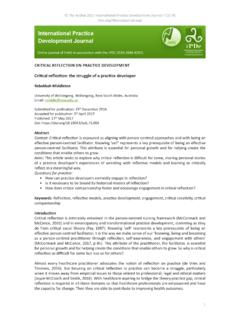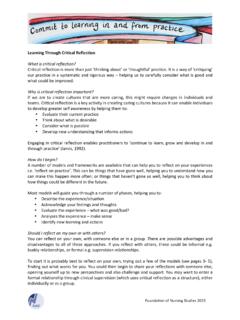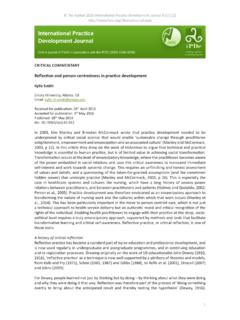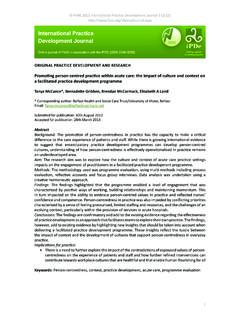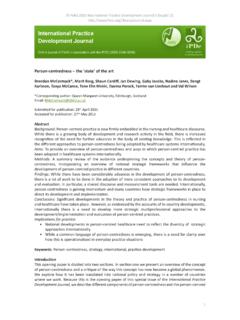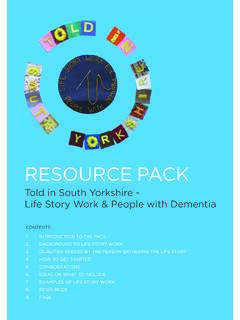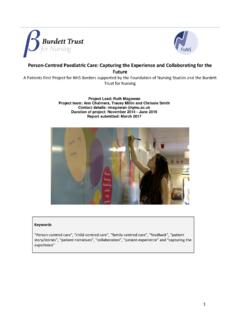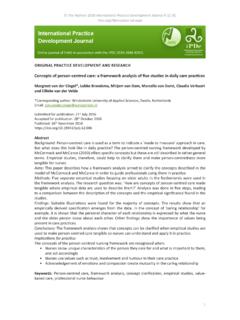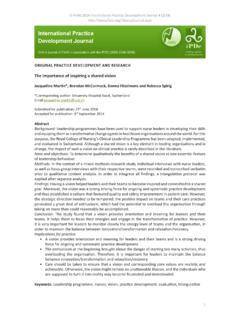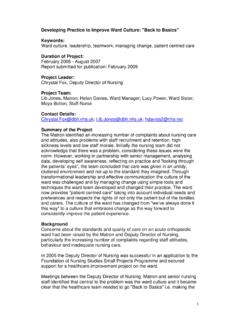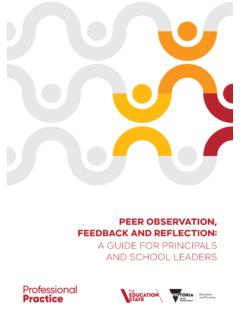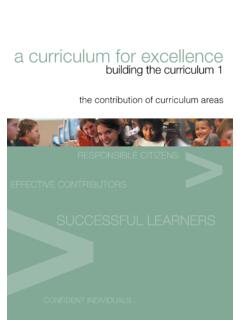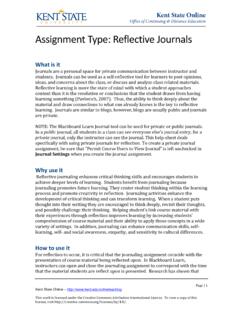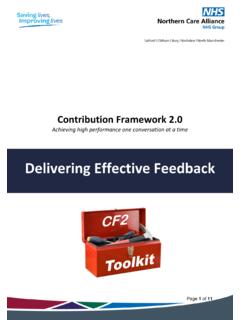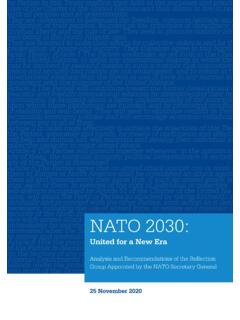Transcription of A reflection on a project to introduce self-‐medication ...
1 FoNS 2012 International Practice Development Journal 2 (2) [10] 1 CCRRIITTIICCAALL RREEFFLLEECCTTIIOONN OONN PPRRAACCTTIICCEE DDEEVVEELLOOPPMMEENNTT AA rreefflleeccttiioonn oonn aa pprroojjeecctt ttoo iinnttrroodduuccee sseellff- - mmeeddiiccaattiioonn oonn aann aaccuuttee mmeeddiiccaall wwaarrdd CCllaaiirree NNuunnnn East Sussex Healthcare NHS Trust, St Leonards- on- Sea, East Sussex. Email: Submitted for publication: 9th June 2012 Accepted for publication: 29th August 2012 AAbbssttrraacctt I have undertaken a reflection of self - medication, the action of patients carrying out their own administration of medications whilst in hospital, using Driscoll s What ?
2 Model of reflection (Driscoll, 2007). The purpose of this is to reflect on how the process of introducing self - medication in hospital affected the team, and impacted on patient care and on my feelings at the time and now. self - medication is considered in the context of a 28- bed acute medical and respiratory ward within the local NHS general hospital, the East Sussex Healthcare NHS Trust, on the south coast of England. reflection improves practice by facilitating understanding of the world of nursing and enhanced care , where developments may not necessarily be as influential as hoped, requiring adaptation and refinement, which reflection can help bring about.
3 Implications for practice: There needs to be an inclusive approach to changes in medicines management Participating staff must be included from an early stage to ensure their concerns over devolved responsibility are addressed Formal patient feedback would be valuable in optimising self - medication KKeeyywwoorrddss: self - administration of medicines, acute hospital environment, nursing practice, reflection IInnttrroodduuccttiioonn self - medication is a programme of administration of medicines whereby individual patients take responsibility for administration of their prescribed regimen following initial assessment and consent, together with ongoing assessment (see Figure 1).
4 The process involves careful selection of patients in terms of cognitive ability, manual dexterity and knowledge of the drug regimen (Vilasuso and Barnett, 2007). self - medication is not a new concept; however it has had limited success within the acute hospital environment. I have chosen to reflect on the introduction of self - medication within our area at a time when it is not widely used, increasing awareness of its role within medicines management and of the suitability of patients. FoNS 2012 International Practice Development Journal 2 (2) [10] 2 FFiigguurree 11 SSEELLFF- - AADDMMIINNIISSTTRRAATTIIOONN OOFF MMEEDDIICCAATTIIOONN AASSSSEESSSSMMEENNTT FFOORRMM PPaattiieenntt ss nnaammee:: DDaattee ooff bbiirrtthh:: WWaarrdd:: HHoossppiittaall nnuummbbeerr:: ((oorr aattttaacchh llaabbeell)) CCoommpplleetteedd bbyy ((nnaammee)) PPhhaarrmmaaccyy:: RRGGNN:: DDaattee ooff aasssseessssmmeenntt:: 1.
5 Does the patient administer their own medication at home? YES / NO 2. Is the patient orientated to time and place? YES / NO 3. Can the patient open the bottles/blister packs and self - administer the medication with/without reasonable adjustments, eg an aid or training? YES / NO 4. Can the patient read the labels? YES / NO 5. Can the patient explain the name of the medication, why they are taking it, the dosage and the main possible side- effects? YES / NO 6. Does the patient have a history of drug/alcohol/substance abuse or self - harm?
6 YES / NO Must answer YYEESS to 1 - 3 to be considered for self - administration. If NNOO to either of 4 or 5, or YYEESS to 6, then the patient is not automatically excluded but support/education needed to facilitate self - administration will need to be identified. II aamm ssaattiissffiieedd ttoo tthhee bbeesstt ooff mmyy kknnoowwlleeddggee tthhaatt tthhee aabboovvee nnaammeedd ppaattiieenntt iiss ccoommppeetteenntt ttoo sseellff- - LLeevveell ooff aaddmmiinniissttrraattiioonn:: 11 22 33 ((pplleeaassee cciirrccllee)) SSiiggnnaattuurree ooff aasssseessssoorr:: NNaammee pprriinntteedd.
7 DDAATTEE QQUUEESSTTIIOONN YY//NN 11 22 33 44 55 66 SSiiggnnaattuurree CCoonnttiinnuuee YY//NN IIff nnoo,, nneeww lleevveell ((11,,22,,33)) CCoonnttrroolllleedd ddrruugg ccoouunntt SSiiggnnaattuurree FoNS 2012 International Practice Development Journal 2 (2) [10] 3 My ward is a 28- bed acute medical ward, specialising in respiratory patients, with a mix of patients with acute illness and exacerbations of a chronic illness, primarily chronic obstructive pulmonary disease.
8 I volunteered our ward to be part of the self - medication project due to my interest in medicines management and my status as a nurse independent prescriber. Practice development seeks to improve patient experience through new and effective person- centred ways of working but it is strongly influenced by local factors within the team and organisation (Canterbury Christ Church University, 2012). reflection involves intellectual and affective activities to examine experience and clarify meaning (Sherwood and Horton Deutsch, 2008).
9 Within nursing, Gibbs (1988) and Johns (2002) are two popular models of reflection but I consider that these focus upon individual experience, rather than on the reflection process within a wider context. Therefore, I have chosen the What? model of structured reflection by Driscoll (2007), (see Figures 2 and 3, below). I recognise though, that reflection is a personal journey on a continuum of growth and development, which blends theory and practice. FFiigguurree 22:: TThhee WWhhaatt?? mmooddeell ooff ssttrruuccttuurreedd rreefflleeccttiioonn ((DDrriissccoollll,, 22000077)) FoNS 2012 International Practice Development Journal 2 (2) [10] 4 FFiigguurree 33:: TTrriiggggeerr qquueessttiioonnss ffoorr tthhee WWhhaatt?
10 ? mmooddeell ooff ssttrruuccttuurreedd rreefflleeccttiioonn ((DDrriissccoollll,, 22000077)) AA ddeessccrriippttiioonn ooff tthhee eevveenntt WWhhaatt?? ttrriiggggeerr qquueessttiioonnss is the purpose of returning to this situation? happened? did I see/do? was my reaction to it? did other people do who were involved in this? AAnn aannaallyyssiiss ooff tthhee eevveenntt SSoo wwhhaatt?? ttrriiggggeerr qquueessttiioonnss How did I feel at the time of the event? Were those feelings I had any different from those of other people who were also involved at the time?
